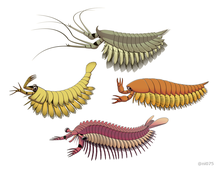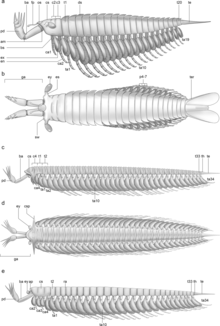Megacheira
Megacheira ("great hands") is an extinct class of predatory arthropods that possessed a pair of great appendages,[1] hence the class' name as well as the common name "great appendage arthropods". Their neural structures and deutocerebral appendages resemble those of chelicerates.[2][3][4][5][6] Most of them were found in marine environments throughout the world from the lower to middle Cambrian. Megacheirans were important components of several faunas, including the Burgess, Wheeler and Maotianshan Shales Lagerstatten.
| Megacheira | |
|---|---|
 | |
| Leanchoilia (top), Haikoucaris (left), Yohoia (right) and Fortiforceps (bottom). | |
| Scientific classification | |
| Kingdom: | Animalia |
| Phylum: | Arthropoda |
| Class: | †Megacheira Hou and Bergström, 1997 |
| Groups | |
| |


Homology of great appendages
The homology between megacheiran great appendages and cephalic appendages of other arthropods had been discussed for decades. There is controversy over whether they are homologous to both dinocaridid (radiodonts and gilled lobopodians) frontal appendages, the frontalmost appendages of Isoxys and chelicerates' chelicerae.[7][5] Based on neuroanatomical evidences, many studies support their homology to chelicerae and first antennae of other arthropods (which are deutocerebral),[4] but not dinocaridid frontal appendages (protocerebral),[8][6][9] A 2020 study suggests that the great appendages of megacheirans and radiodonts are homologous and casts doubt on the validity of suspected neuroanatomical evidences.[10]
Taxonomy
The monophyly of Megacheira is uncertain, and megacheirans are either suggested to be stem-group chelicerates or stem-group arthropods,[6] with the former hypothesis based on the chelicerae-like morphology of great appendages[11][7][5] alongside neuroanatomy[4] and reduced labrum[12] resembled to those of a modern chelicerate. As an example of the latter hypothesis, A study in 2020 found that Megacheria was paraphyletic, forming a grade of arthropods more derived than Dinocaridids and Isoxys, but less than crown arthropods (chelicerates + mandibulates), with Jianfengiids being more basal and the Haikoucaris + Yohoia + Leancholiids clade (Cheiromorpha) closer to crown athropods.[10]
Genera referred to the class include Yohoia, Haikoucaris, Leanchoilia, Alalcomenaeus, Yawunik, Oestokerkus, Jiangfengia, Fortiforceps, Tanglangia, Actaeus, Kootenichela, Worthenella and Sklerolibyon.[13] Parapeytoia, which formerly misinterpreted as a radiodont was later reveal to be a member of this group.[14][15][16] The class might also contain Enalikter aphson described from the Silurian Herefordshire Lagerstätte of the United Kingdom, and Bundenbachiellus giganteus known from the Early Devonian of Germany;[17][18] although the interpretation of these taxa as megacheirans was challenged by Struck et al. (2015).[19] The claim that Enalikter was an annelid was subsequently rebutted by some of the original authors in 2017.[20] Kootenichela has been suggested to be a chimera of various arthropod taxa.[10] Previous inclusion of some "bivalved" genus such as Forfexicaris, Ovalicephalus, and Occacaris to Megacheira was questioned by later investigations.[6]
External links
- Stein, Martin (March 2010) [26 February 2010]. "A new arthropod from the Early Cambrian of North Greenland, with a 'great appendage'-like antennula". Zoological Journal of the Linnean Society. 158 (3): 477–500. doi:10.1111/j.1096-3642.2009.00562.x.
- Stolte, Daniel (16 October 2013). "Extinct 'Mega Claw' Creature Had Spider-Like Brain". University of Arizona.
- "Extinct 'mega claw' creature had spider-like brain" (Press release). ScienceDaily. 16 October 2013.
- Tanaka, Gengo; Hou, Xianguang; Ma, Xiaoya; Edgecombe, Gregory D.; Strausfeld, Nicholas J. (17 October 2013). "Chelicerate neural ground pattern in a Cambrian great appendage arthropod". Nature. 502 (7471): 364–367. doi:10.1038/nature12520. PMID 24132294.
- Haug, Joachim T.; Waloszek, Dieter; Maas, Andreas; Liu, Yu; Haug, Carolin (March 2012). "Functional morphology, ontogeny and evolution of mantis shrimp-like predators in the Cambrian: MANTIS SHRIMP-LIKE CAMBRIAN PREDATORS". Palaeontology. 55 (2): 369–399. doi:10.1111/j.1475-4983.2011.01124.x.
- Ortega-Hernández, Javier; Janssen, Ralf; Budd, Graham E. (2017-05-01). "Origin and evolution of the panarthropod head – A palaeobiological and developmental perspective". Arthropod Structure & Development. Evolution of Segmentation. 46 (3): 354–379. doi:10.1016/j.asd.2016.10.011. ISSN 1467-8039. PMID 27989966.
- Chen, Jun-Yuan (2009). "The sudden appearance of diverse animal body plansduring the Cambrian explosion". The International Journal of Developmental Biology. 53 (5–6): 733–751. doi:10.1387/ijdb.072513cj. ISSN 1696-3547. PMID 19557680.
- Cong, Peiyun; Ma, Xiaoya; Hou, Xianguang; Edgecombe, Gregory D.; Strausfeld, Nicholas J. (2014). "Brain structure resolves the segmental affinity of anomalocaridid appendages". Nature. 513 (7519): 538–542. doi:10.1038/nature13486. ISSN 1476-4687. PMID 25043032.
- Park, Tae-Yoon S.; Kihm, Ji-Hoon; Woo, Jusun; Park, Changkun; Lee, Won Young; Smith, M. Paul; Harper, David A. T.; Young, Fletcher; Nielsen, Arne T.; Vinther, Jakob (2018-03-09). "Brain and eyes of Kerygmachela reveal protocerebral ancestry of the panarthropod head". Nature Communications. 9 (1): 1019. doi:10.1038/s41467-018-03464-w. ISSN 2041-1723. PMC 5844904. PMID 29523785.
- Aria, Cédric; Zhao, Fangchen; Zeng, Han; Guo, Jin; Zhu, Maoyan (December 2020). "Fossils from South China redefine the ancestral euarthropod body plan". BMC Evolutionary Biology. 20 (1): 4. doi:10.1186/s12862-019-1560-7. ISSN 1471-2148. PMC 6950928. PMID 31914921.
- Chen, Junyuan; Waloszek, Dieter; Maas, Andreas (2004). "A new 'great-appendage' arthropod from the Lower Cambrian of China and homology of chelicerate chelicerae and raptorial antero-ventral appendages". Lethaia. 37 (1): 3–20. doi:10.1080/00241160410004764. ISSN 1502-3931.
- Liu, Yu; Ortega-Hernández, Javier; Zhai, Dayou; Hou, Xianguang (2020-06-25). "A Reduced Labrum in a Cambrian Great-Appendage Euarthropod". Current Biology. 0 (0). doi:10.1016/j.cub.2020.05.085. ISSN 0960-9822. PMID 32589912.
- Legg, David (May 2013). "Multi-Segmented Arthropods from the Middle Cambrian of British Columbia (Canada)". Journal of Paleontology. 87 (3): 493–501. doi:10.1666/12-112.1. ISSN 0022-3360.
- Stein, Martin (2010-03-01). "A new arthropod from the Early Cambrian of North Greenland, with a 'great appendage'-like antennula". Zoological Journal of the Linnean Society. 158 (3): 477–500. doi:10.1111/j.1096-3642.2009.00562.x. ISSN 0024-4082.
- Xian-Guang, Hou; Siveter, David J.; Siveter, Derek J.; Aldridge, Richard J.; Pei-Yun, Cong; Gabbott, Sarah E.; Xiao-Ya, Ma; Purnell, Mark A.; Williams, Mark (2017-04-24). The Cambrian Fossils of Chengjiang, China: The Flowering of Early Animal Life. John Wiley & Sons. ISBN 9781118896389.
- Daley, Allison C.; Budd, Graham E.; Caron, Jean-Bernard; Edgecombe, Gregory D.; Collins, Desmond (2009-03-20). "The Burgess Shale Anomalocaridid Hurdia and Its Significance for Early Euarthropod Evolution". Science. 323 (5921): 1597–1600. doi:10.1126/science.1169514. ISSN 0036-8075. PMID 19299617.
- Siveter, Derek J.; Briggs, Derek E. G.; Siveter, David J.; Sutton, Mark D.; Legg, David; Joomun, Sarah (7 March 2014). "A Silurian short-great-appendage arthropod". Proceedings of the Royal Society B. 281 (1778): 20132986. doi:10.1098/rspb.2013.2986. PMC 3906945. PMID 24452026.
- Derek J. Siveter; Derek E. G. Briggs; David J. Siveter; Mark D. Sutton; David Legg; Sarah Joomun (2015). "Enalikter aphson is an arthropod: a reply to Struck et al. (2014)". Proceedings of the Royal Society B. 282 (1804): 20142663. doi:10.1098/rspb.2014.2663. PMC 4375861.
- Torsten H. Struck; Carolin Haug; Gerhard Haszprunar; Nikola-Michael Prpic; Joachim T. Haug (2015). "Enalikter aphson is more likely an annelid than an arthropod: a comment to Siveter et al. (2014)". Proceedings of the Royal Society B. 282 (1804): 20140946. doi:10.1098/rspb.2014.0946. PMC 4375853. PMID 25716792.
- Parry, Luke A.; Legg, David A.; Sutton, Mark D. (April 2017). "Enalikter is not an annelid: homology, autapomorphies and the interpretation of problematic fossils". Lethaia. 50 (2): 222–226. doi:10.1111/let.12196. hdl:10044/1/53297.